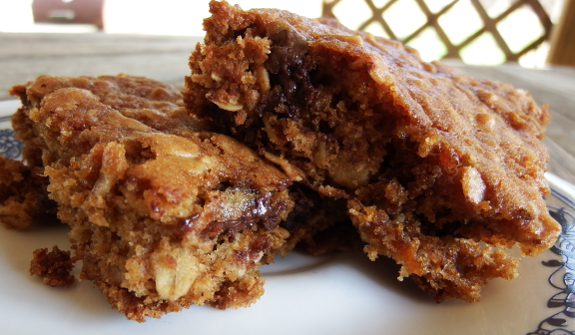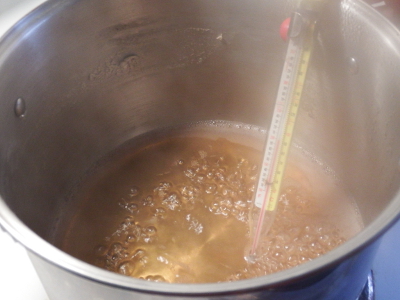
Boiling down birch syrup

The different types of
sugars in birch sap compared to maple sap make birch syrup a little
trickier to boil down. It's imperative not to allow the developing syrup
to get above 200 degrees Fahrenheit with birch sap unless you want the
sugars to caramelize, darkening the color and impacting the flavor. In
addition, it's a bit trickier to know when birch syrup is done since it
doesn't get as thick as maple syrup, so you'll need to make your best
guess, then weigh the finished product to determine how close you are to
the optimal 11 pounds per gallon.
 Luckily,
our birch tree started running hard when the warm weather came around,
and several days in a row of 1.75-gallon yields gave me enough condensed
sap to try my hand at syrup making. I ended up with about a quarter of a
cup of syrup from three gallons of sap, at a weight of 3.3 ounces for
the final product, which means I actually cooked the liquid down a bit
further than is optimal (even though the syrup still looked pretty
runny, even when cool). This equates to about 192 gallons of sap per
gallon of syrup, requiring half again as much boiling down as even the box-elder sap we experimented with last month and three times as much boiling as our sugar maple sap.
Luckily,
our birch tree started running hard when the warm weather came around,
and several days in a row of 1.75-gallon yields gave me enough condensed
sap to try my hand at syrup making. I ended up with about a quarter of a
cup of syrup from three gallons of sap, at a weight of 3.3 ounces for
the final product, which means I actually cooked the liquid down a bit
further than is optimal (even though the syrup still looked pretty
runny, even when cool). This equates to about 192 gallons of sap per
gallon of syrup, requiring half again as much boiling down as even the box-elder sap we experimented with last month and three times as much boiling as our sugar maple sap.
With a larger supply of
syrup on hand, we were able to try out a more in-depth tasting, this
time substituting birch syrup for the sorghum molasses in our favorite
oatmeal cookie bar recipe. The result was delectable! I'll include the
recipe in my upcoming ebook, Farmstead Feast: Spring, due out in March, but if you'd like some farm-friendly recipes while you wait, Farmstead Feast: Winter is still for sale for only 99 cents. Enjoy!
Want more in-depth information? Browse through our books.
Or explore more posts by date or by subject.
About us: Anna Hess and Mark Hamilton spent over a decade living self-sufficiently in the mountains of Virginia before moving north to start over from scratch in the foothills of Ohio. They've experimented with permaculture, no-till gardening, trailersteading, home-based microbusinesses and much more, writing about their adventures in both blogs and books.
Want to be notified when new comments are posted on this page? Click on the RSS button after you add a comment to subscribe to the comment feed, or simply check the box beside "email replies to me" while writing your comment.
- Remove comment
